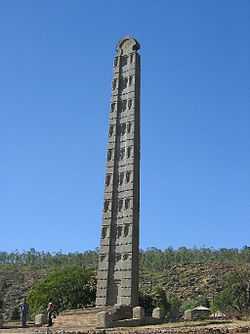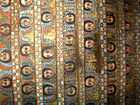Ethiopian art
.jpg)

Ethiopian art from the 4th century until the 20th can be divided into two broad groupings. First comes a distinctive tradition of Christian art, mostly for churches, in forms including painting, crosses, icons, illuminated manuscripts, and other metalwork such as crowns. Secondly there are popular arts and crafts such as textiles, basketry and jewellery, in which Ethiopian traditions are closer to those of other peoples in the region. Its history goes back almost three thousand years to the kingdom of D'mt. The Ethiopian Orthodox Tewahedo Church has been the predominant religion in Ethiopia for over 1500 years, for most of this period in a very close relation, or union, with the Coptic Christianity of Egypt, so that Coptic art has been the main formative influence on Ethiopian church art.
Overview
Prehistoric rock art comparable to that of other African sites survives in a number of places, and until the arrival of Christianity stone stelae, often carved with simple reliefs, were erected as grave-markers and for other purposes in many regions; Tiya is one important site. The "pre-Axumite" Iron Age culture of about the 5th century BCE to the 1st century CE was influenced by the Kingdom of Kush to the north, and settlers from Arabia, and produced cities with simple temples in stone, such as the ruined one at Yeha, which is impressive for its date in the 4th or 5th century BCE.
The powerful Kingdom of Axum emerged in the 1st century BCE and dominated Ethiopia until the 10th century CE, having become very largely Christian from the 4th century.[1] Though some buildings, and large pre-Christian stelae, survive, there appears to be no surviving Ethiopian Christian art from the Axumite period. However the earliest works remaining show a clear continuity with Coptic art of earlier periods. There was considerable destruction of churches and their contents in the 16th century when the country was invaded by Muslim neighbours. The revival of art after this was influenced by Catholic European art in both iconography and elements of style, but retained its Ethiopian character. In the 20th century Western artists and architects began to be commissioned by the government, and to train local students, and more fully Westernized art was produced alongside continuations of traditional church art.[2]
Types of Art
Painting

Ethiopian painting, on walls, in books, and in icons, is highly distinctive, though the style and iconography are closely related to the simplified Coptic version of Late Antique and Byzantine Christian art. It is typified by simplistic, almost cartoonish, figures with large, almond-shaped, eyes. Colours are usually bright and vivid. The majority of paintings are religious in nature, often decorating church walls and bibles. One of the best known examples of this type of painting is at Debre Berhan Selassie in Gondar (pictured), famed for its angel covered roof (angels in Ethiopian art are often represented as winged heads) as well as its other murals dating from the late 17th century. Diptychs and triptychs are also commonly painted with religious icons.[3] From the 16th century Roman Catholic church art, and European art in general, began to exert some influence, but Ethiopian art is highly conservative, and retained much of its distinct character until modern times, with the production of illuminated manuscripts for use continuing up to the present day.[4] Pilgrimages to Jerusalem, where there has long been an Ethiopian clerical presence, also allowed some contact with a wider range of Orthodox art.
Churches may be very fully painted though until the 19th century there is little sign of secular painting, other than scenes commemorating the life of donors to churches on their walls. Unusually for Orthodox Christianity, icons were not usually kept in houses (where talimanic scrolls were often kept instead), but in the church. Some "diptyches" are in the form of a "ark" or tabot, in these cases consecrated boxes with a painted inside of the lid, placed closed on the altar during Mass, somewhat equivalent to the altar stone in the Western church, and the antimins in other Orthodox churches. These are regarded as so holy that the laiety is not allowed to see them, and they are wrapped in cloth when taken in procession.
Ethiopian "diptychs" often have a primary wing with a frame, and a smaller second wing which is only the size of the image within the frame, and is painted on both sides to allow closed and open views. Icons are painted on a wood base support, but since about the 16th century with an intervening cloth support glued to a gesso layer above the wood. The binding medium for the paint is also animal-based glue, giving a matt finish which is then often varnished. A range of mostly mineral pigments are used, giving a palette based on reds, yellow and blues. Underdrawing was used, which may remain visible or reinforced by painted edges to areas of colour in the final layer.
From the 15th century the Theotokos or Virgin Mary, with or with her Child, became increasingly popular, using versions of a number of common Byzantine types, typically flanked by two archangels in iconic depictions. She is often depicted with a neighbouring image of a mounted Saint George and the Dragon, who in Ethiopian Christianity is regarded as especially linked to Mary, for carrying messages or intervening in human affairs on her behalf.
Crosses and other metalwork
Another important form of Ethiopian art, also related to Coptic styles, are crosses made from wood and metal, usually copper alloy or brass, plated (at least originally) with gold or silver. The heads are typically flat cast plates with elaborate and complex openwork decoration. The cross motif emerges from the decoration, with the whole design often forming a rotated square or circular shape, though the designs are highly varied and inventive. Many incorporate curved motifs rising from the base, which are called the "arms of Adam". Except in recent Western-influenced examples, they usually have no corpus, or figure of Christ, and the design often incorporates numerous smaller crosses. Engraved figurative imagery has sometimes been added. Crosses are mostly either processional crosses, with the metal head mounted on a long wooden staff, carried in religious processions and during the liturgy, or hand crosses, with a shorter metal handle in the same casting as the head. Smaller crosses worn as jewellery are also common.
.jpg)
The Lalibela Cross is an especially venerated hand cross, perhaps of the 12th century, which was stolen from a church in Lalibela in 1997 and eventually recovered and returned from a Belgian collector in 2001.
Distinctive forms of crown were worn in ceremonial contexts by royalty and important noble officials, as well as senior clergy. Royal crowns rose high, with a number of circular bands, while church crowns often resemble an elongated version of the typical European closed crown, with four arms joined at the top and surmounted by a cross.
Other arts and crafts
Ethiopia has great ethnic and linguistic diversity, and styles in secular traditional crafts vary greatly in different parts of the country. There are a range of traditions in textiles, many with woven geometric decoration, although many types are also usually plain. Ethiopian church practices make a great deal of use of colourful textiles, and the more elaborate types are widely used as church vestments and as hangings, curtains and wrappings in churches, although they have now largely been supplanted by Western fabrics. Examples of both types can be seen in the picture at the top of the article. Icons may normally be veiled with a semi-transparent or opaque cloth; very thin chiffon-type cotton cloth is a speciality of Ethiopia, though usually with no pattern.
Colourful basketry with a coiled construction is common in rural Ethiopia. The products have many uses, such as storing grains, seeds and food and being used as tables and bowls. The Muslim city of Harar is well known for its high quality basketry,[5] and many craft products of the Muslim minority relate to wider Islamic decorative traditions.
Gallery
-
.jpg)
Stone statue from Addi-Galamo, Tigray Province, 6th - 5th century BCE
-
Stelae in the royal cemetery at Tiya
-

The Obelisk of Axum, 4th century
-

12th century processional cross
-

Depiction of John the Evangelist in one of the Gunda Gunde Gospels, circa 1540
-

Bible from a monastery on Lake Tana, 12th-13th century
-

Page from Gunda Gunde Gospel, circa 1540
-

Small pendant diptych icon with St George and the Virgin and Child, late 18th century
-
_-_Walters_3610_-_Open.jpg)
Folding book
-

19th century pendant cross
-

The roof of Debre Berhan Selassie church
-

Folding Processional Icon in the Shape of a Fan
-
Painting of Solomon, Ethiopian Chapel in the Church of the Holy Sepulchre
-

Assisted by St George (top), Ethiopian forces win the Battle of Adowa against the Italian invasion of Ethiopia in 1896, painted 1965-75
Notes
- ↑ Biasio
- ↑ Biasio
- ↑ "Ethiopia, its Art and Icons". Retrieved 22 June 2012.
- ↑ Ross
- ↑ "Ethiopian Handicraft". Retrieved 22 June 2012.
References
| Wikimedia Commons has media related to Art of Ethiopia. |
- Biasio, Elisabeth, "Ethiopia and Eritrea." Grove Art Online. Oxford Art Online. Oxford University Press. Web. 4 Feb. 2013. subscription needed
- Horowitz, Deborah Ellen et al., Ethiopian Art: The Walters Art Museum, 2001, Walters Art Gallery, Baltimore/Third Millennium Information Ltd, ISBN 1903942020, 9781903942024, google preview
- Ross, Emma George. "African Christianity in Ethiopia". In Heilbrunn Timeline of Art History. New York: The Metropolitan Museum of Art, 2000–. (October 2002)
| |||||||||||


